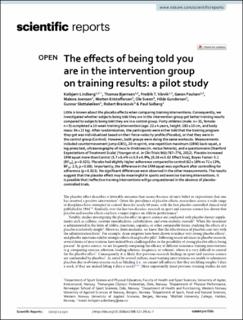| dc.contributor.author | Lindberg, Kolbjørn Andreas | |
| dc.contributor.author | Bjørnsen, Thomas | |
| dc.contributor.author | Vårvik, Fredrik Tonstad | |
| dc.contributor.author | Paulsen, Gøran | |
| dc.contributor.author | Joensen, Malene | |
| dc.contributor.author | Kristoffersen, Morten | |
| dc.contributor.author | Sveen, Ole | |
| dc.contributor.author | Gundersen, Hilde | |
| dc.contributor.author | Slettaløkken, Gunnar | |
| dc.contributor.author | Brankovic, Robert | |
| dc.contributor.author | Solberg, Paul André | |
| dc.date.accessioned | 2023-10-23T13:15:16Z | |
| dc.date.available | 2023-10-23T13:15:16Z | |
| dc.date.created | 2023-04-13T12:41:30Z | |
| dc.date.issued | 2023 | |
| dc.identifier.citation | Scientific Reports. 2023, 13(2023), Artikkel 1972. | en_US |
| dc.identifier.issn | 2045-2322 | |
| dc.identifier.uri | https://hdl.handle.net/11250/3098166 | |
| dc.description | This article is licensed under a Creative Commons Attribution 4.0 International License, which permits use, sharing, adaptation, distribution and reproduction in any medium or format, as long as you give appropriate credit to the original author(s) and the source, provide a link to the Creative Commons licence, and indicate if changes were made. The images or other third party material in this article are included in the article's Creative Commons licence, unless indicated otherwise in a credit line to the material. If material is not included in the article's Creative Commons licence and your intended use is not permitted by statutory regulation or exceeds the permitted use, you will need to obtain permission directly from the copyright holder. | en_US |
| dc.description.abstract | Little is known about the placebo effects when comparing training interventions. Consequently, we investigated whether subjects being told they are in the intervention group get better training results compared to subjects being told they are in a control group. Forty athletes (male: n = 31, female: n = 9) completed a 10-week training intervention (age: 22 ± 4 years, height: 183 ± 10 cm, and body mass: 84 ± 15 kg). After randomization, the participants were either told that the training program they got was individualized based on their force–velocity profile (Placebo), or that they were in the control group (Control). However, both groups were doing the same workouts. Measurements included countermovement jump (CMJ), 20-m sprint, one-repetition maximum (1RM) back-squat, a leg-press test, ultrasonography of muscle-thickness (m. rectus femoris), and a questionnaire (Stanford Expectations of Treatment Scale) (Younger et al. in Clin Trials 9(6):767–776, 2012). Placebo increased 1RM squat more than Control (5.7 ± 6.4% vs 0.9 ± 6.9%, [0.26 vs 0.02 Effect Size], Bayes Factor: 5.1 [BF10], p = 0.025). Placebo had slightly higher adherence compared to control (82 ± 18% vs 72 ± 13%, BF10: 2.0, p = 0.08). Importantly, the difference in the 1RM squat was significant after controlling for adherence (p = 0.013). No significant differences were observed in the other measurements. The results suggest that the placebo effect may be meaningful in sports and exercise training interventions. It is possible that ineffective training interventions will go unquestioned in the absence of placebo-controlled trials. | en_US |
| dc.language.iso | eng | en_US |
| dc.subject | physiology | en_US |
| dc.subject | psychology | en_US |
| dc.title | The effects of being told you are in the intervention group on training results: A pilot study | en_US |
| dc.type | Peer reviewed | en_US |
| dc.type | Journal article | en_US |
| dc.description.version | publishedVersion | en_US |
| dc.rights.holder | © The Author(s) 2023 | en_US |
| dc.source.pagenumber | 10 | en_US |
| dc.source.volume | 13 | en_US |
| dc.source.journal | Scientific Reports | en_US |
| dc.identifier.doi | 10.1038/s41598-023-29141-7 | |
| dc.identifier.cristin | 2140571 | |
| dc.description.localcode | Institutt for fysisk prestasjonsevne / Department of Physical Performance | en_US |
| dc.source.articlenumber | 1972 | en_US |
| cristin.ispublished | true | |
| cristin.fulltext | original | |
| cristin.qualitycode | 1 | |
